Exploring homeownership among young Virginians
Households can be one of two things: owned or rented. The homeownership rate equals the share of households that are owned. Therefore, a rise in the homeownership rate indicates a rise in the number of households electing to own their home rather than rent in a given area. Essentially, homeownership can provide an idea of where householders have the best chances of buying a home if they so desire.
Virginia is just now seeing the first significant increase in homeownership since before the housing crisis. According to annual data from the American Community Survey, two-thirds of occupied homes in Virginia were owned in 2017 – a 1.3 percent increase over 2016. Homeownership is increasing at an even greater rate among members of Virginia’s younger generation, who are catching up following the negative impact of the recession. Young adults, defined here as those age 15 to 34, had a homeownership rate increase of 1.6 percent between 2016 and 2017, reaching 34.8 percent. The homeownership rate among those other than young adults (greater than 34 years old) was 73.7 percent – an increase of 1.0 percent.
How does young Virginian homeownership vary across the state? What underlying causes are driving changes in the homeownership rate? What does this information indicate and imply for Virginia counties and cities? This commentary aims to explore the above questions.
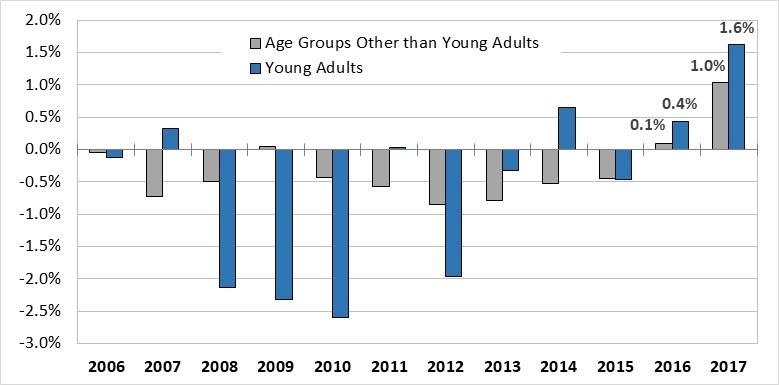
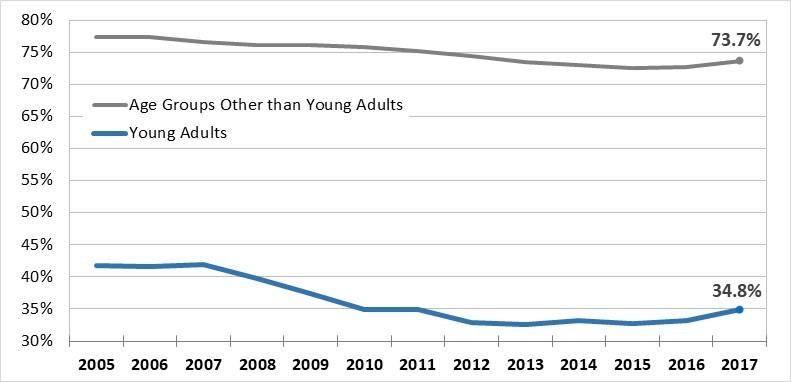
Source: Census Bureau American Community Survey, 1-year estimates
Homeownership rates among young adults vary widely across the state, from a low of 9.4 percent in the Cities of Radford and Williamsburg to a high of 74 percent in New Kent County. Low young adult homeownership is present in areas with college towns as well as cities with expensive housing and where renting may be preferable. Most high young adult homeownership jurisdictions lie in exurban areas surrounding employment centers, where housing is less expensive yet commuting is reasonable. The map in Figure 4 below uses 2016, 5-year average Census data which provides a complete picture with reliable data for every jurisdiction in Virginia – not only the 32 with populations over 65,000 available in the 2017 1 year estimates.
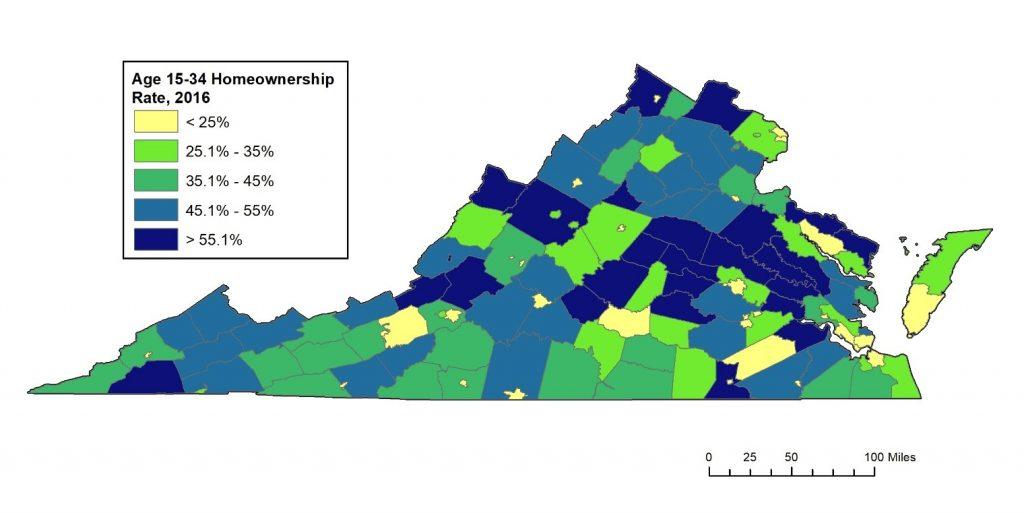
Source: Census Bureau American Community Survey, 2016 5 year estimates
The geographic variability across the state in young adult homeownership highlights some interesting insights. Where are young adults living, and where is it economically feasible?
The map in Figure 4 shows jurisdictions with a high percentage of young adult households in red (above the Virginia rate of 19.2 percent), jurisdictions with a high percentage of owned young adult households in yellow (above the Virginia rate of 33.3 percent), and jurisdictions with both in green. The green counties suggest areas where young adults may both want and/or need to live (primarily tied to job location) and where they may also be able to purchase their own home.
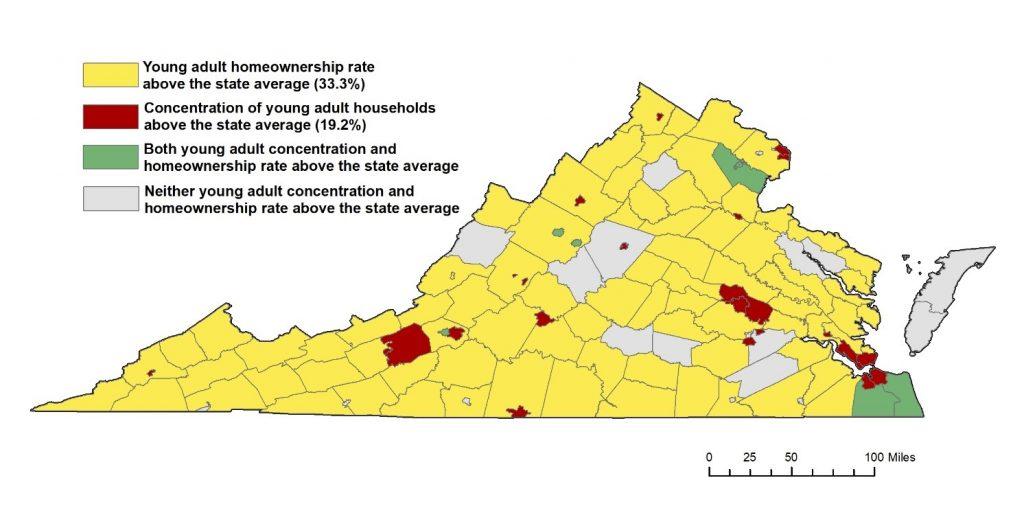
Source: Census Bureau American Community Survey, 2016 5 year estimates
Unsurprisingly, most of the jurisdictions with a high concentration of young adults are in denser urban areas where job centers are located. Most of these (in red) have low young adult homeownership, likely related to issues of affordability and availability. Arlington County has the second largest young adult concentration yet the lowest young adult homeownership rate in the state.
The majority of the areas with high young adult homeownership yet low concentrations of young adults are less densely populated and largely rural. The high homeownership among the fewer young adults (in the yellow areas) is likely a factor of necessity and relative affordability – rental units are sparse and homes are cheaper. The optimal conditions (in green) where young adults are living in high numbers and they are able to purchase a home are rare.
The Hampton Roads region stands out with both a high young adult concentration and high young adult homeownership. The cities of Virginia Beach and Chesapeake both have about 20 percent of their households headed by a young adult and have 34 and 44 percent homeownership rates, respectively, among that group. Portsmouth has a high young adult concentration and homeownership rate just below the state average at 30 percent. Prince William County and the cities of Manassas and Manassas Park show positive conditions for young adults as well, with high young adult homeownership rates between 40 and 50 percent and a young adult household concentration between 20 and 24 percent. These DC suburbs are showing that they are still relatively affordable for entry-level housing while attracting young adults who may work in the surrounding job centers.
It is important to note that Henrico County, surrounding Richmond, is very close to optimal (green), with a high young adult household concentration (20 percent) but a young adult homeownership rate of 31.5 percent, which is about 1.5 percent below the state average.
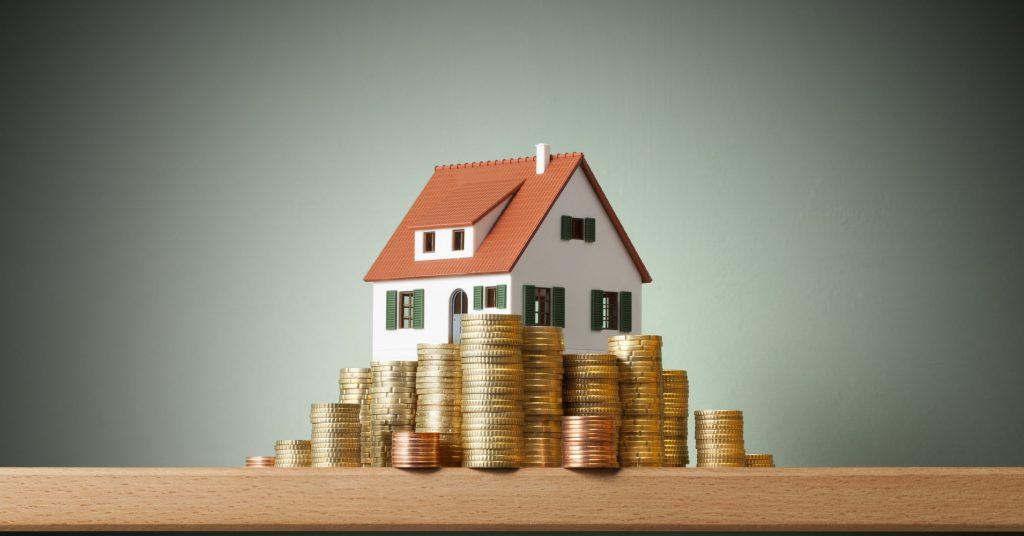
At the end of the day, homeownership is driven by the availability of affordable homes for purchase and their location relative to job markets. Economic ability is one of the primary challenges facing young potential homebuyers. Increasing education debt has reduced young adults’ likelihood of owning a home, with outstanding student loans equaling $1.53 trillion in the second quarter of 2018, according to the Federal Reserve. High rental costs also make it difficult for young adults to save for a down payment.
The household value to income ratio is an indicator of housing affordability measured by dividing the value of an owned home by the household income of its occupants. This ratio signifies the number of years of income it would take to purchase an average home. Historically, U.S. median home values have been roughly 2.5 to 3 times median income. (What price is “affordable” to a buyer with a given income depends partly on mortgage terms). In Figure 5, we see the percentage of owned homes with a household value to income ratio greater than three. As expected, relative to income, homes are less affordable near job centers such as Northern Virginia and Virginia Beach. Despite these affordability challenges, young adults are concentrating in these areas, and their homeownership rate is relatively high and rising. The choice between budget stretching or moving further outwards from the city continues.
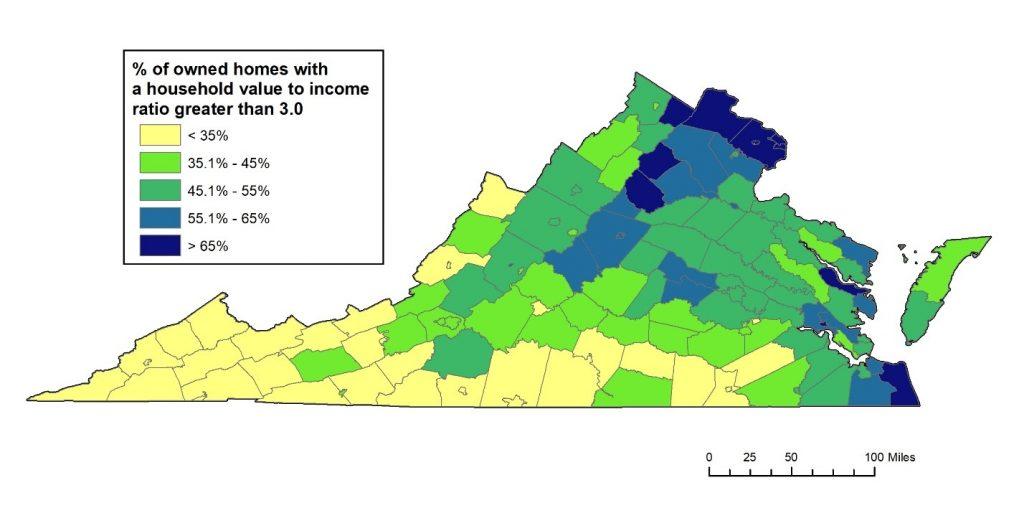
Source: Census Bureau American Community Survey, 2016 5 year estimates


